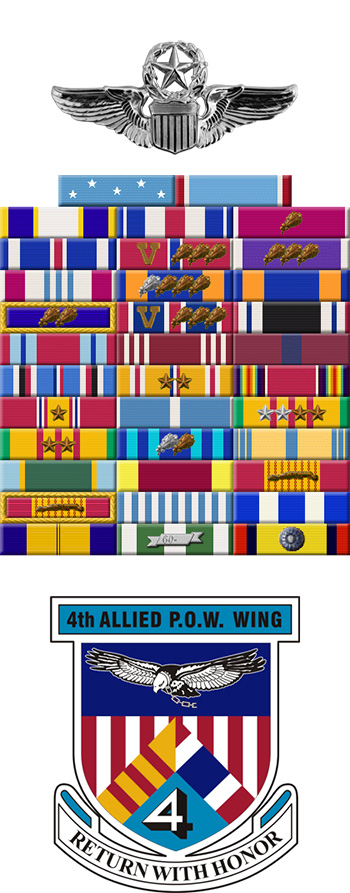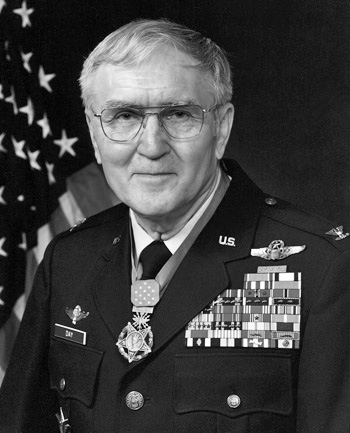
|
George E. "Bud" Day |
 |
|||
| Rank, Service | ||||
Brigadier General O-7, U.S. Air Force |
||||
| Veteran of: | ||||
|
||||
| Tribute: | ||||
Bud Day was born on February 24, 1925, in Sioux City, Iowa. He enlisted in the U.S. Marine Corps on December 10, 1942, and spent 30 months in the South Pacific during World War II before receiving an honorable discharge on November 24, 1945. After the war, Day joined the U.S. Army Reserve on December 11, 1946, and served until December 10, 1949. He was appointed a 2d Lt in the Iowa Air National Guard on May 17, 1950, and went on active duty in the U.S. Air Force on March 15, 1951. Lt Day completed pilot training and was awarded his pilot wings at Webb AFB, Texas, in September 1952, and completed All-Weather Interceptor School and Gunnery School in December 1952. He served as an F-84 Thunderjet pilot with the 559th Strategic Fighter Squadron of the 12th Strategic Fighter Wing at Bergstrom AFB, Texas, from February 1953 to August 1955, with deployments to Omisawa, Japan, during this time in support of the Korean War. His next assignment was as an F-84 and F-100 Super Sabre pilot with the 55th Fighter Bomber Squadron of the 20th Fighter Bomber Wing and later on the wing staff at RAF Wethersfield, England, from August 1955 to June 1959, followed by service as an Assistant Professor of Aerospace Science at the Air Force ROTC detachment at St. Louis University in St. Louis, Missouri, from June 1959 to August 1963. During his service in England, he became the first person ever to live through a no-chute bailout from a jet fighter. Capt Day attended Armed Forces Staff College for Counterinsurgency Indoctrination training at Norfolk, Virginia, from August 1963 to January 1964, and then served as an Air Force Advisor to the New York Air National Guard at Niagara Falls Municipal Airport, New York, from January 1964 to April 1967. Maj Day then deployed to Southeast Asia, serving first as an F-100 Assistant Operations Officer at Tuy Hoa AB, South Vietnam, before organizing and serving as the first commander of the Misty Super FACs at Phu Cat AB, South Vietnam, from June 1967 until he was forced to eject over North Vietnam and was taken as a Prisoner of War on August 26, 1967. He managed to escape from his captors and make it into South Vietnam before being recaptured and taken to Hanoi. After spending 2,028 days in captivity, Col Day was released during Operation Homecoming on March 14, 1973. He was briefly hospitalized to recover from his injuries at March AFB, California, and then received an Air Force Institute of Technology assignment to complete his PhD in Political Science at Arizona State University from August 1973 to July 1974. His final assignment was as an F-4 Phantom II pilot and Vice Commander of the 33rd Tactical Fighter Wing at Eglin AFB, Florida, from September 1974 until his retirement from the Air Force on December 9, 1977. MISTY 1, Col Bud Day, Flew West on July 27, 2013, and was buried at Barrancas National Cemetery at NAS Pensacola, Florida. He was posthumously promoted to the rank of Brigadier General (O-7) on June 8, 2018. His Medal of Honor Citation reads: On 26 August 1967, Col. Day was forced to eject from his aircraft over North Vietnam when it was hit by ground fire. His right arm was broken in 3 places, and his left knee was badly sprained. He was immediately captured by hostile forces and taken to a prison camp where he was interrogated and severely tortured. After causing the guards to relax their vigilance, Col. Day escaped into the jungle and began the trek toward South Vietnam. Despite injuries inflicted by fragments of a bomb or rocket, he continued southward surviving only on a few berries and uncooked frogs. He successfully evaded enemy patrols and reached the Ben Hai River, where he encountered U.S. artillery barrages. With the aid of a bamboo log float, Col. Day swam across the river and entered the demilitarized zone. Due to delirium, he lost his sense of direction and wandered aimlessly for several days. After several unsuccessful attempts to signal U.S. aircraft, he was ambushed and recaptured by the Viet Cong, sustaining gunshot wounds to his left hand and thigh. He was returned to the prison from which he had escaped and later was moved to Hanoi after giving his captors false information to questions put before him. Physically, Col. Day was totally debilitated and unable to perform even the simplest task for himself. Despite his many injuries, he continued to offer maximum resistance. His personal bravery in the face of deadly enemy pressure was significant in saving the lives of fellow aviators who were still flying against the enemy. Col. Day's conspicuous gallantry and intrepidity at the risk of his life above and beyond the call of duty are in keeping with the highest traditions of the U.S. Air Force and reflect great credit upon himself and the U.S. Armed Forces. |
||||
|
||||

